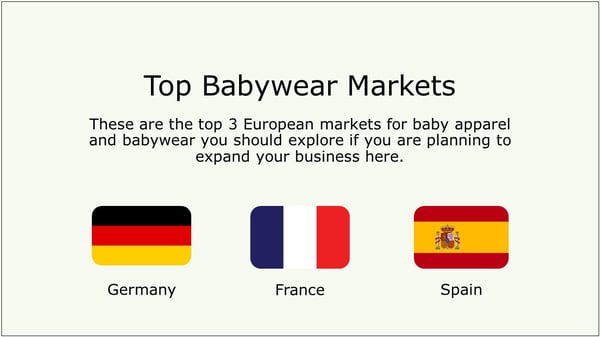European Baby Clothes Market: Size, Trends & Opportunities
Numbers talk, and according to Fortune Business Insights, the baby clothing market is expected to reach USD 82.54 billion by 2027. The market size was steady until 2019, but then, modern-age parents helped boost the growth.
If you want to learn more about the European baby clothes market potential, this blog is a must-read.
Emerging Trends in Babywear Fashion
Thanks to the developments in medical science, infant mortality rates are reducing. On the other hand, many fertility techniques are perfected. This combination led to an increased number of newborns.
Infants up to the age of 24 months outgrow their clothing sizes rapidly. That is why there is a constant need to purchase new clothes, which leads to the growth of the babywear market in Europe.
Many modern parents are following the newest babywear trends. The majority of big brands are launching their children's clothing lines or collaborating with some brands that are already in the industry. Especially since matching parents' and kids' clothes are getting more in demand.
Due to social media, with the increasing trends for baby photoshoots, the demand for stylish baby garments is growing.
Insights on the Baby Clothing Market
When it comes to the product type, we can segment the market into top wear and bottom wear. These segments are further divided per particular clothing item. The fact that bodysuits are convenient for dapper change makes it predictable to become a big hit when it comes to European children's clothing.
The children's wear market is also segmented based on materials that are used for clothing.
Geographically speaking, the main children's apparel industry leaders are Europe and North America.
Expanding to the European Baby Clothes Market
Euro baby clothes market leaders are Germany, France, and Spain, followed by the Netherlands, the UK, and Italy. Together, these six countries represent over 72% of the EU’s baby apparel exports. Currently, 60% of the value of EU babywear imports originates from outside the EU, while the remaining 40% originates from inside. The European babywear market is expected to grow annually by 2.50%.

If you are planning your EU expansion, you should consider these locations first, as we bring you a brief overview of the top European baby clothes market in 2022 numbers:
Babywear market in France
- The predicted revenue of the babywear market in France in 2022: USD 1,233m
- Expected annual growth: 1.19%
- The average purchasing volume per person in 2022: 3.18
Babywear market in Germany
- The predicted revenue of the babywear market in Germany in 2022: USD 1,331m
- Expected annual growth: 1.18%
- The average purchasing volume per person in 2022: 1.79
Babywear market in the United Kingdom
- The predicted revenue of the babywear market in the UK in 2022: USD 1,936m
- Expected annual growth: 2.60%
- The average purchasing volume per person in 2022: 2.40
Babywear market in Spain
- The predicted revenue of the babywear market in Spain in 2022: USD 1,004m
- Expected annual growth: -0.18%
- The average purchasing volume per person in 2022: 2.86
Babywear market in Italy
- The predicted revenue of the babywear market in Italy in 2022: USD 1,526m
- Expected annual growth: 1.24%
- The average purchasing volume per person in 2022: 2.15
Babywear market in the Netherlands
- The predicted revenue of the babywear market in the Netherlands in 2022: USD 92m
- Expected annual growth: 1.90%
- The average purchasing volume per person in 2022: 2.34
Key Highlights on the Babyclothes Market 2022
In many developed and developing countries, the effect of Instagram and other social media platforms is taking its toll. Parents are using these platforms to post photos of themselves and their children in matching outfits. Therefore, some of the leading fashion brands are creating their products in kids' sizes as well.
Thanks to this trend, the industry keeps growing, making the babywear market a multi-billion in Europe. And the increased number of born babies is helping as well.
More information
Interested to learn more about your company's potential to expand into the European baby clothes market?
We are the experts in the field! Feel free to schedule a meeting with us, and we will be more than happy to guide you through your European expansion. For additional information, visit Sales Outsourcing.
Category
Related articles
-

People Analytics: Transforming HR for European Expansion
17 September 2024Discover how people analytics can transform HR management, aiding companies in navigating the...
Read more -

Navigating Retail Recruitment and Employment in Europe's Top Markets.
30 August 2024Explore retail recruitment and employment, labor insights, and strategic hiring approaches in...
Read more -

Leveraging the European Hospitality Industry for Retail Success
24 May 2024Leverage the European hospitality industry to drive retail success by accessing a global customer...
Read more

